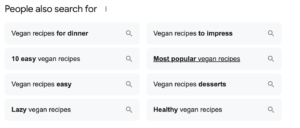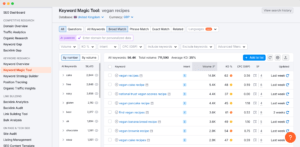
In the early days of the Internet, getting your website to rank on the first page of Google was dictated by keywords.
You could boost your traffic by packing your pages with keywords and pumping out endless content around different phrases.
Today, the web has moved on – and that’s a good thing.
Google now rewards businesses that best meet their customers’ (yes, the searcher is also Google’s customer) needs with helpful content.
While keywords are still a vital part of SEO in 2024, they need to be used more intuitively and with far greater planning.
This means that not only do you need to understand what your target audience is searching for, but why, and what they’re expecting to find at the end of their search.
What is keyword research?
Keyword research is the process of researching what your target audience is looking for when they use search engines. When performing keyword research you are looking for keywords that are relevant to your audience, and that you have the authority to write about and that have a search volume to bring in traffic.
These keywords – like “plant nurseries in London”, “buy scarves online UK”, or even just “compost” – form the core of any SEO strategy.
When conducting keyword research, you want to be able to answer the following questions:
- What is my audience searching for?
- Why are they searching for it?
- How many people are searching for it?
- How competitive is this keyword to rank for?
Being able to answer these questions thoroughly, and ideally for different buyer personas, will help you to understand how users find your website and what content they are expecting when they arrive there.
Why is keyword research important for SEO?
Keyword research will help you identify what your users are interested in based on what they’re searching for.
While search engine algorithms have moved away from promoting pages only based on keywords that match a user’s search, they are still a vital part of a page’s visibility on search engines.
Keyword research also allows you to identify the questions your audiences are asking, but that haven’t been answered yet, so you can close that opportunity gap.
With this information, you can plan your content around user interests that not only help readers but gains organic traffic and broadens your audience reach.
What vs. Why behind keywords
There are two parts to understanding your audience via the keywords they type into Google:
- What your customers are looking for (these are the actual keywords)
- Why they are looking for it (these are the underlying reasons behind the keywords)
You can only answer the “Why?” if you know your audience well enough. You can only understand your online audience if you have conducted thorough buyer persona research.
Download our FREE guide to building buyer personas
We can design and implement a campaign for your business that will start driving targeted traffic to your business instantly.
Let’s have a look at how to do intent-driven keyword research and analysis in 2024.
Step 1: Make a list of topics that are relevant to your target audiences
To get started, you need to make a list of topics that are relevant to your business, using your common sense and what you already know about your audience.
This can take as much or as little time as you want, but the more ideas you have, the better.
Once you know what topics you want to cover, you need to put yourself in your audiences’ shoes. Think about what traffic you want to attract, who those people are, and what problems they’re facing. It’s important to understand the language they use to describe their problems, too.
If you’re selling a product, you need to understand why your product offers a solution to your audience.
For example, if you’re selling a hanging bird table, understanding the specific reason your audience would want that product (to attract more birds to their garden, because it’s easier to clean than competing products, or even because it has a desirable style) will be better for your SEO than targeting generic topics. To expand your keyword list away from the generic, consider using tools that can extract people also search phrases in Google, providing further insights into related queries.
Step 2: Search forums to expand those topics
Once you’ve got an idea of what your audience is searching for, what problems they have, and how they’re trying to solve them, it’s time to delve into forums to expand your topics even further.
Forums have a large number of people, concentrated in one place, who all have the same interests. They provide an incredibly accurate example of how people talk – and therefore, search.
Within our SEO services we use different tools to scrape forums when we do keyword research for our clients, but you can also just copy and paste topics manually into Excel – it just takes longer and can be overwhelming to analyse if you’re new to Excel formulas.
We can design and implement a campaign for your business that will start driving targeted traffic to your business instantly.
Quora.com and Reddit.com are two of the most popular forums, but there are highly niche forums for any industry. You can use Findaforum tool to find a forum for your niche.
Not only is this a great way to tailor your content to what your users are specifically looking for, but it can also be a golden opportunity to find long-tail (5+ word) keywords with large volume and little competition.
Long-tail keywords are often easier to rank for than shorter keywords.
If forums aren’t for you, you can also explore related search terms. This can be a valuable step in your keyword research process, especially if you’re looking to expand your keyword list. If you haven’t yet considered this approach, it’s an excellent way to discover additional relevant keywords.
To find related search terms, enter your primary keyword into Google and scroll to the bottom of the search results page. There, you’ll see a list of suggested searches related to your original query. These suggestions can provide inspiration for additional keywords and help you identify variations and related topics.

By the end of this step, you should have a list of 1000+ keywords in Excel (or less if you’re collecting keywords manually).
Step 3: Understand what keywords your competitors rank for
Understanding what keywords your competitors rank for can give you ideas about what your audience may be searching for – and therefore, care about.
Semrush is one of the most valuable tools for competitor keyword research, as it allows you to see not only what your competitors are ranking for, but what keywords they’re using in their pay-per-click (PPC) advertising. PPC keywords are important because they show which keywords bring a positive return on investment (ROI).
Semrush will also allow you to check each keyword for metrics like organic click-through rate (CTR), competition, and how difficult it is to rank for that keyword. Regarding keyword difficulty, Mangools shares a few tips to consider:
- Use Keyword Difficulty as a guideline, not as an absolute value.
- Each tool shared different Keyword Difficulty metrics.
- Always consider your website’s authority and how relevant your content is.
Semrush allows you to easily export all data in Excel, which you can add to your existing list.
Step 4: Uncover your keywords with targeted research
Now you’ve got an idea of what keywords are working for your competitors and your niche, you can start to expand those into long-tail keywords that work with the language your audience uses.
Thankfully, there are a lot of free and paid tools available to help you with this.
Free keyword research tool – AnswerThePublic
AnswerThePublic is one of the most comprehensive keyword research tools. It will take the keywords you provide, expand them into questions, and show related searches.

Free(ish) keyword research tool – ChatGPT
ChatGPT can be a useful tool for keyword research by assisting with brainstorming and refining keyword lists. You can start by providing a topic or seed keyword, and ChatGPT can generate a variety of related terms and long-tail keywords. This helps in expanding your initial list and exploring new possibilities based on current trends and common search patterns.
Additionally, ChatGPT can aid in understanding search intent and generating content ideas. By analysing the context and purpose behind specific keywords, ChatGPT helps ensure your content aligns with user expectations
Free keyword research tool – Soovle
Soovle uses a similar format, and it covers popular search engines like Google, Amazon, YouTube, and Yahoo!. Typing your keyword into this engine will give you the top searches for that keyword, which can help inspire you not only for what keywords to use but what content to create.

The only downside of Soovle is that you can’t export the keywords, which is why at Digivate we use the paid tool, Semrush, which has similar but more advanced features.
Paid keyword research tool – Semrush
Semrush is renowned for its comprehensive keyword research features. Its Keyword Magic Tool provides extensive keyword suggestions, filters, and metrics like search volume, keyword difficulty, and competitive density. Semrush also offers a Keyword Gap tool that allows users to compare their keyword strategies with competitors, identifying opportunities and gaps.
Additionally, its PPC Keyword Tool helps refine paid search strategies by providing insights into keyword performance across both organic and paid search.

Additional tools
Incorporating social listening tools like Hootsuite or Brandwatch into your keyword research strategy can provide valuable insights into current trends and audience conversations.
These tools analyse social media platforms and online forums to track what your audience is talking about, revealing emerging keywords and topics that might not be captured through traditional keyword research methods. By monitoring discussions, hashtags, and sentiment, you can uncover new opportunities for content creation and keyword targeting.
For example, if you notice a growing conversation around a specific topic within your industry, you can quickly adjust your keyword strategy to include these emerging terms, keeping your content relevant and aligned with what your audience is actively searching for.
Step 5: Group keywords by search intent
Once you’ve compiled a list of keywords using the techniques and tools we recommend in steps 1-4, you can begin organising them in a way that helps you decipher which will be the most valuable for you to pursue.
The first option with this is to organise them by search intent.
Search intent is the goal someone has in mind when they type something into Google search.
There are 4 main search intents:
- Informational: The intent is to find particular information e.g. the user wants to learn more about SEO best practices
- Transactional: The intent is to perform an activity or purchase e.g. the user wants to hire particular SEO services for their company
- Navigational: The intent is to reach a particular site or page e.g. the user is looking for Digivate’s SEO services
- Commercial: The intent is to investigate brands or services e.g. the user is looking for the best SEO experts or services.
It’s obvious that when users search for phrases beginning with “how to…” they’re looking for guides or tutorials, but there is often a lot more nuance that gets overlooked.
Can you guess what people want to find when they type in a word:
“Facebook”
“baseball”
“dresses with sleeves”
PRO TIP! You can easily find out the search intent behind every keyword by typing it into Google search and analysing the 1st-page results.
In 2024, search engines like Google have built algorithms that are extremely efficient at identifying a user’s intention, so you can trust Google’s judgment on what the intent behind the keyword is by simply looking at SERPs (search engine results page).
My quick analysis shows that “Facebook” is a navigational query (i.e people want to find facebook.com page); “baseball” is an informational query (i.e people want to find out what is baseball, how it’s played, what the world-known teams are, etc); and the “dresses with sleeves” is a transactional query (i.e people want to buy a dress with sleeves there and then).
Why is search intent important?
Understanding what your audience is looking for when they search your keyword is crucial to improving your rankings.
You don’t want to mistakenly create blog content that targets transactional keywords. Equally, you don’t want to try to rank for “Facebook” by writing the article “What is Facebook and how it works?” because this is not what people want when they search for “Facebook”.
On a side note, Google’s emphasis on E-E-A-T (Experience, Expertise, Authoritativeness, Trustworthiness) underscores the need for high-quality, relevant content. Understanding search intent helps you create content that meets these standards, especially for YMYL (Your Money or Your Life) topics where accuracy and trust are paramount.
Step 6: Group keywords by business value
This step is very similar to the one above but focuses more on how the keywords you’ve identified fit in with your business goals.
Now that you understand user intention, you can begin to narrow down your list of keywords that fit with how you want users to behave on your website.
As an example, let’s say your goal is to increase traffic and user engagement with your cooking website. This means you’ll want to focus on using keywords that have a high CTR and traffic but don’t necessarily have high revenue potential. With this in mind, you might focus on publishing more recipes and tutorials, and targeting very specific keywords like “vegan slow cooker recipes with chickpeas”.
While these keywords wouldn’t necessarily generate much revenue, you’ll potentially rank higher and generate more backlinks, which will increase your overall domain authority and as a result – make your site more visible for other more transactional terms going forward.
Step 7: Choose keywords that allow you to create content clusters
Content clusters are a strategic approach to organising related keywords around a central pillar of content, creating a well-structured site architecture.
By grouping related topics under a core piece of content, you build topic authority and enhance your site’s relevance in the eyes of search engines. This method not only improves site navigation but also boosts search engine rankings by signalling to Google that your content is comprehensive and authoritative on specific subjects.
For instance, if you run a cooking website, a pillar page on “Vegan Recipes” can be supported by cluster content such as “Vegan Breakfast Ideas” and “Easy Vegan Dinner Recipes,” all interlinked to reinforce your expertise in vegan cuisine.

Step 8: Prioritise your keywords
This isn’t necessarily a step on its own as much as it is a process you’ll naturally go through as you do keyword research, but it’s worth mentioning that you should be noting the following things:
- Estimated potential traffic
- Competition or keyword difficulty
- Estimated ROI of incoming traffic
- Resource investment in ranking for that keyword
While some keywords might seem like a great choice, it’s usually the keywords with a high ROI that you want to target.
This return on investment often looks different to every business, so it’s up to you to decide whether the keywords you’ve found through your research will work for your business.
For smaller websites that may be keywords with a low keyword difficulty but still enough volume. Whereas bigger websites can go for the keywords with the highest search volume straight off the bat.
Remember, when conducting keyword research, considering localisation is crucial, particularly for businesses targeting multiple regions. Keywords can vary significantly in search intent and volume depending on the geographic location.
For instance, the term “football” might refer to soccer in most countries, but in the United States, it’s commonly associated with American football. By incorporating localisation into your keyword strategy, you can tailor your content to match the specific terminology and search behaviours of different regions. This means conducting separate keyword research for each target market to ensure that your content resonates with local audiences and addresses their unique search intents.
Summary: How to do keyword research and analysis in 2024
Keyword research is a vital part of your SEO strategy.
After all, keywords are what a user uses to find your website in the first place. Remember, effective keyword research is not just about ranking higher but about delivering valuable and relevant content that meets user expectations. Implementing these strategies ensures that your content not only attracts traffic but also provides a seamless and satisfying experience for your audience.
We hope this guide helped you to understand the value of keyword research and how to find out the intention behind the keywords, so you can create content that meets the expectations of your target audience.



